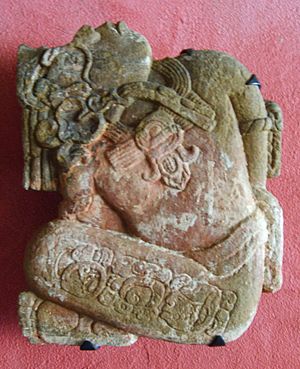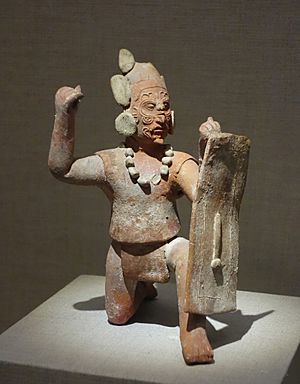Maya warfare facts for kids
For a long time, people thought the ancient Maya were a peaceful society. But new discoveries show that fighting between different Maya cities was very common. This warfare played a big part in how Maya society grew and changed. We don't fully understand why they fought, but experts have learned a lot. They study old city defenses, art and writings about war, and weapons like obsidian blades found in the ground. Sometimes, archaeologists find signs of sudden violence that changed how a city worked.
Maya cities often fought to control people and important resources. Some experts believe that capturing people for sacrifice was a main reason for war. Key resources included water and good farming land. Controlling valuable materials like obsidian also made cities compete more. As cities became stronger, they also became more complex. This helped them get and keep resources, often by using their military. More people meant more competition, which led to more fighting.
Contents
Why Did the Maya Fight?
Warfare and Beliefs
Warfare was a major reason for cultural change among the Maya. While leaders gained power and wealth, a main goal was often to capture people for sacrifice. Sacrifices helped a ruler stay in power. They scared rivals and impressed citizens. Sacrifice was also linked to sacred rituals and the passing of time. The Maya creation story, the Popol Vuh, even talks about sacrifice. Important events, like a leader's death or a new heir's birth, might have needed sacrifices.
How Maya Armies Fought
We don't know much about how the ancient Maya planned their attacks. But Maya cities were often far apart. The average distance was about 55 kilometers. This would take two to eight days to travel.
This distance suggests that war was mainly fought by and for the rich and powerful. This was because of the long journeys between cities. Experts guess that maybe 500 to 1000 warriors fought on each side. This is based on how much food and supplies they could carry on such long trips.
It's thought that warriors would first throw weapons from far away. As they got closer, the fighting likely became less organized. Individual warriors would try to show their bravery. Most ordinary people probably didn't fight in these wars. They only got involved if a ruler was being overthrown.
The way Maya armies were organized isn't fully clear. The main leader was usually the Halach Uinik. This was the ajaw, or lord, of each city-state.
Maya Weapons
The Maya had projectile weapons like the atlatl and spears. But much of the fighting happened up close. Weapons were mostly made from obsidian and chert. Obsidian was very sharp, but it broke easily. Warriors made sharp points from chert or obsidian. They attached these to atlatl darts, spears, and arrows. While bows and arrows were used, spears and Macuahuitl (a type of wooden sword with obsidian blades) were more common. Chipped flint was also used for close-combat knives.
Maya War Sites
Mayapan: A Walled City
Mayapan is in the Mexican state of Yucatán. It was one of the last big Pre-Columbian Maya cities. The city had a strong defensive wall around it. Signs of a big fire show that violence caused its downfall.
Aguateca: A Fortified City
Aguateca is a Classic Maya site in Guatemala. It was part of a group of cities called the Petexbatún States. These included cities like Dos Pilas and Seibal.
Aguateca was built on a high cliff, 90 meters tall. It had strong defenses around the city. Writings and art from the site show that Aguateca's rulers became very powerful in the 8th century. This was a time of constant warfare in the region. During this period, they quickly built 4 kilometers of defensive walls around the city.
Weapons found at Aguateca include chert and obsidian points. Small chert points were likely used as arrowheads. Many obsidian spear tips were found, showing they were a main weapon. Other weapons included darts and atlatl darts.
Aguateca shows that royal leaders were directly involved in warfare. For example, broken chert points were found in royal homes. Also, all obsidian flakes from making weapons were found in royal or elite areas. This suggests that rulers, scribes, and artists at Aguateca also fought as warriors.
The city was attacked and destroyed around 810 AD. Many people left the city quickly, leaving behind many items. It seems the attackers wanted to end Aguateca's power, not to take over the city.
Colha: A Weapon-Making Center
Colha is in north-central Belize. It's about 52 kilometers north of Belize City. Colha was rich in chert, a stone used for tools and weapons. It gives us a good look at Maya warfare during the Terminal Classic period. Colha made many stone tools from the early Classic to the Post Classic periods. A huge chert quarry was nearby, making weapon production easy. These tools were even sent to other regions. Colha was captured and later abandoned.
The end of Colha tells us about the reasons for Maya warfare. Archaeologists found the Colha Skull Pit, which held the remains of 30 human skulls. Another mass grave at Colha was unusual for a Maya burial site. This suggests it was not a ritual grave. It was likely dug when Colha was captured. Even though Colha was already a major tool-making site, the number of stemmed blades (weapons) increased greatly. This, along with many human remains inside the city walls, suggests the people were ready for an invasion. These findings show that capturing Colha was a smart move by an enemy. It cut off the supply of weapons for the area.
La Blanca: Abandoned Acropolis
The main palace area of La Blanca in Petén shows signs of warfare. During the Late Classic period, people could easily access the palace. But in the Terminal Classic, stairways and doorways were blocked. Some buildings were completely sealed. This blocking of access shows how unstable the region was. The city's leaders left the palace in the Terminal Classic. Many flint projectile points were found near the surface. Also, remains of two people were found. This suggests a violent fight happened when the city was abandoned.
Caracol: A Victorious City
Caracol is in western Belize. Researchers have found evidence of at least 33 wars involving Caracol. From about 550 AD to after 790 AD, Caracol fought many wars. Its enemies included Tikal, Palenque, and Naranjo. Caracol won its early wars against Tikal. This stopped Tikal from making new monuments for 120 years, while Caracol grew. Caracol also defeated Naranjo. Caracol kings are shown at Naranjo on monuments. Because Naranjo is halfway between Tikal and Caracol, controlling Naranjo helped Caracol defeat Tikal for a long time.
Becan: A City with a Ditch
Work at Becan in the central Yucatán found a large ditch. It had a raised bank inside, surrounding the city's main center. Even though Becan was smaller than Mayapan, its defensive wall was much bigger.
Tikal: Dispelling the Peace Myth
In 1966, a 9.5-kilometer-long earthwork was found north of Tikal's center. This discovery helped change the idea that the Maya were peaceful. This earthwork was built between 400 and 550 AD. Later studies suggested it might not have been a working defense system. However, ancient writings show that Tikal had violent conflicts with other cities, including Caracol.
Warfare in Maya Writing
Experts have found four main Maya hieroglyphs that describe different types of warfare. There are other symbols related to violence, but these four are the most common.
Chucʼah: The Capture Glyph
This glyph was first identified in 1960. It usually shows one or more tied-up people. There's some debate about whether it means capturing specific people or symbolizing captured towns.
Chʼak: The "Axe Event" Glyph
The Chʼak glyph means a major battle. These battles were important to the winners. But they usually didn't completely destroy the losing city. In most cases, the defeated city wasn't affected much.
Hubi: The Destruction Glyph
This glyph seems to mean "achieving specific goals in war." It is often used when talking about the wars between Naranjo and Caracol.
The "Star-War" Glyph
The "star-war" is thought to be the most important type of warfare shown in Maya art and writing. It means a huge war that led to one city defeating another. This could mean a new ruling family was put in place. It could also mean one city completely controlled another. Or it could mean a city that was once controlled gained its freedom.
Why Maya Cities Collapsed
Constant warfare is often named as a reason for the collapse of the Maya civilization. It led to many cities being abandoned. While fighting certainly played a role, other factors were also important. These included too many people, damage to the environment, and long droughts. The best information about this comes from sites in the Petexbatún region and recent studies at Cancuén.
Old Ideas About Maya Warfare

At the start of the 20th century, many believed the ancient Maya were a mostly peaceful society. This idea made the native culture seem perfect. But this view was wrong. It came from poorly studied art and Maya script. The discovery of murals at Bonampak showing war scenes helped change this idea.
Maya Warfare in Movies
Maya warfare was a big part of the movie Apocalypto (2006), directed by Mel Gibson. The film shows warriors attacking a village. They capture men to sacrifice them on a pyramid during a solar eclipse. The warfare in the movie, like other parts of Late Postclassic Maya society, is not always historically accurate. Richard Hansen, a historical consultant for the film, mostly studied early Maya civilization. This was more than a thousand years before the time shown in the movie.
The 1963 film Kings of the Sun also starts with a conflict. It shows warriors from Chichén Itzá using obsidian weapons. They fight invaders led by Hunac Ceel who use metal swords. These metal swords are not historically accurate for the time. Catapults and fire trenches shown in the movie are also likely not accurate.



